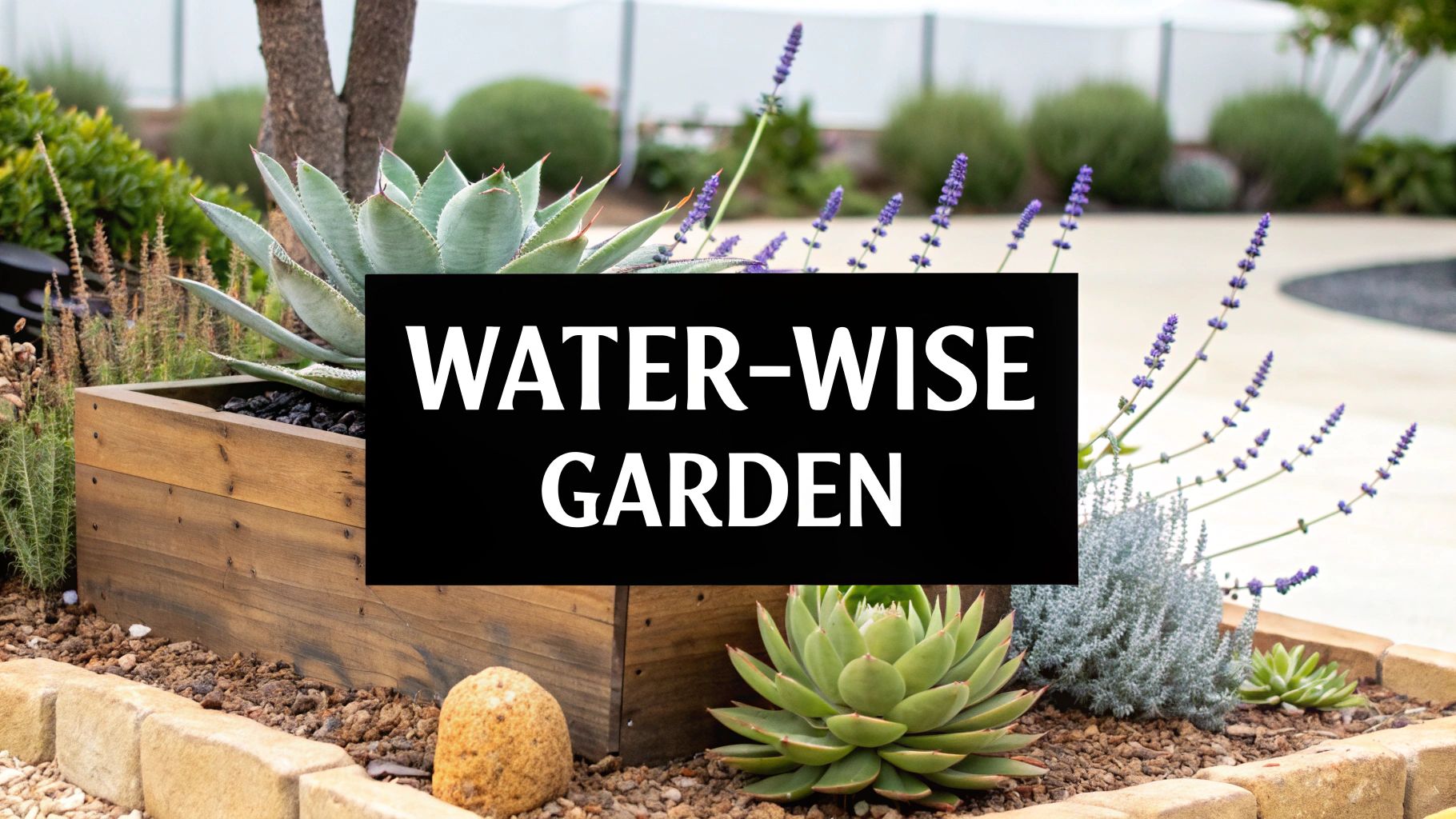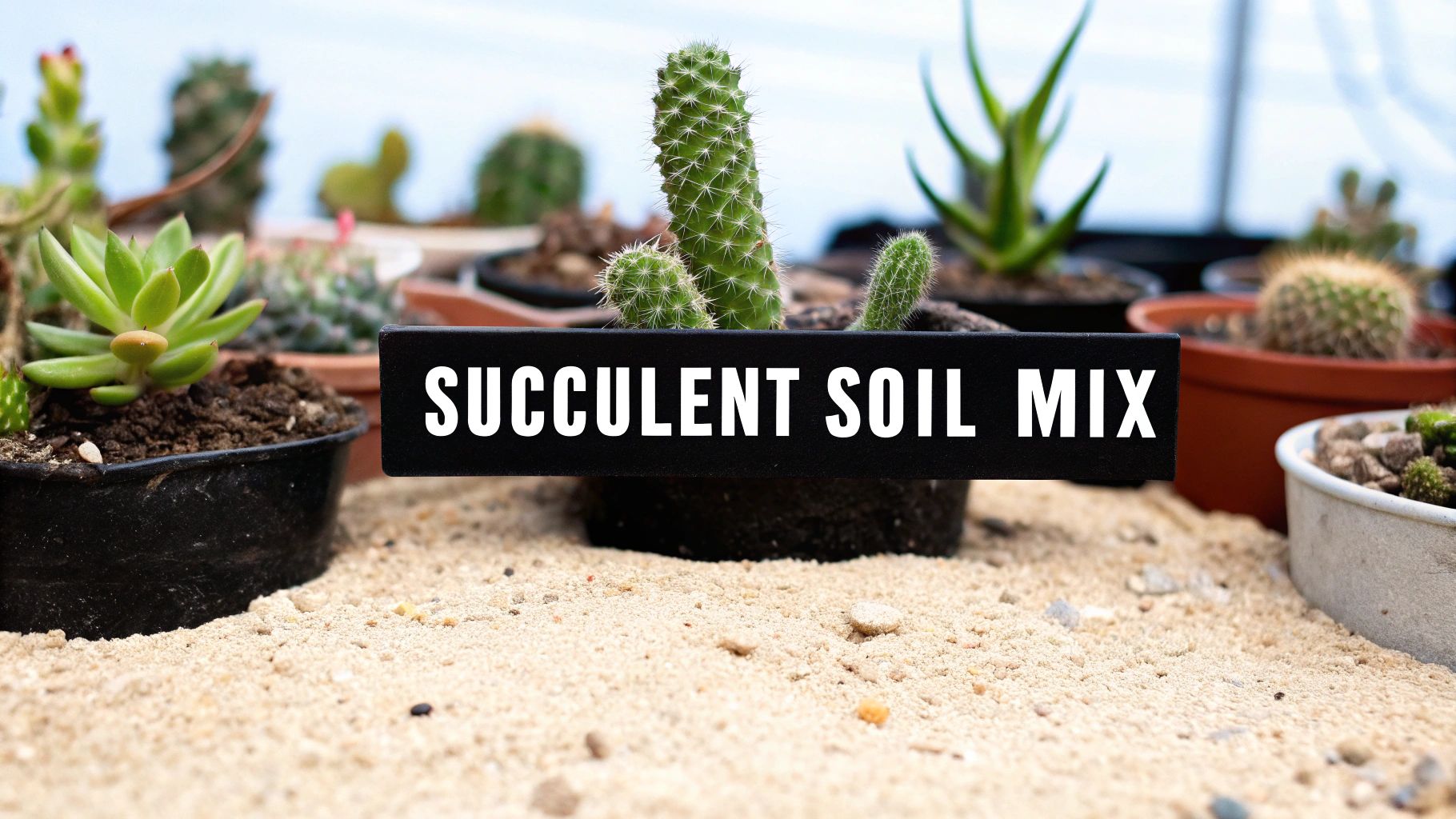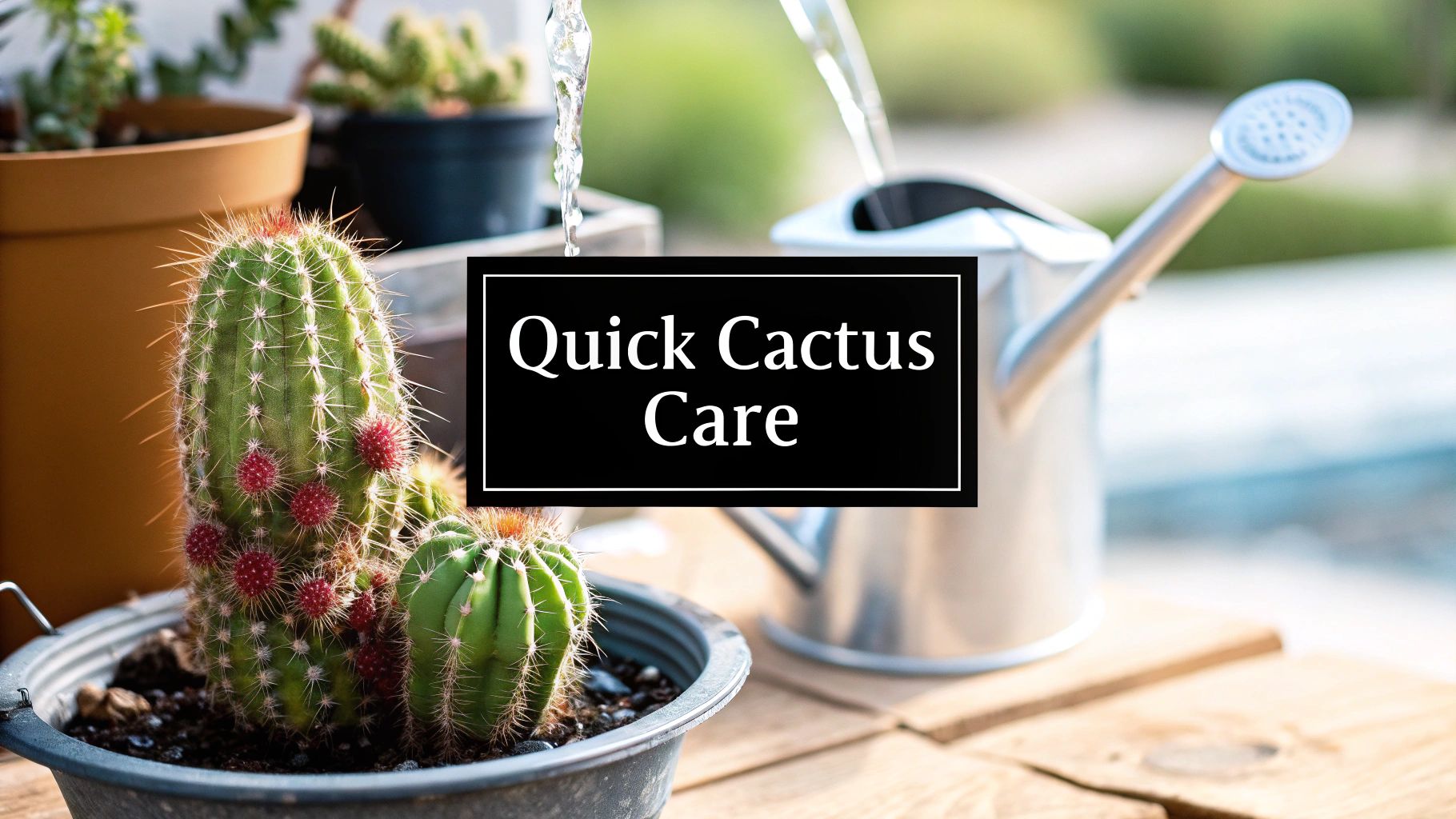If you're looking for a gorgeous garden without being chained to the hose, some of the best drought tolerant plants are absolute lifesavers. Think of stunning, resilient choices like Lavender, Agave, and Sedum. These tough plants bring vibrant color and texture to your yard but ask for very little water once they get their roots down, making them perfect for a sustainable, low-effort landscape.
Why Go for a Water-Wise Garden?
Picture a garden that looks fantastic even in the sweltering heat of August, one that doesn't just survive a dry spell, but actually thrives. That's the real magic of a drought-tolerant garden. This isn't just about following a trend; it's a smart, practical way to create a beautiful space that can handle whatever the weather throws at it.
A garden packed with the right water-wise plants can be surprisingly lush and full of life. When you choose species that are naturally built for dry conditions, you're essentially working with nature instead of fighting it. That simple shift makes gardening so much more rewarding and a whole lot less work.
The Big Wins of a Drought-Tolerant Garden
- Serious Water Savings: Let's start with the most obvious perk—you'll use way less water. For many homes, outdoor watering can make up over 30% of total household water use. Planting species that don't need constant irrigation is a direct hit to your water bill and a huge help for conserving a vital resource.
- Less Work, More Enjoyment: Once these plants are established, they pretty much take care of themselves. That means less time spent watering, fussing with fertilizer, and pruning. You get to spend more time just relaxing and enjoying the beautiful space you've created.
- Boosts Your Curb Appeal: A water-wise garden is anything but dull and sparse. In fact, you can create incredible designs with dramatic shapes, deep colors, and fascinating textures. Plants like Coneflower and Yarrow provide brilliant pops of color, proving that you never have to sacrifice beauty for practicality.
A well-planned water-wise garden doesn't just survive; it flourishes. You're creating a dynamic, living space that is both stunning and environmentally smart.
For gardeners who really want to lean into self-sufficiency, collecting rainwater is a great next step. If you're looking to store water for those rare times you do need to supplement, it helps to explore different types of vertical water storage tanks to find a solution that fits your space. It's a forward-thinking approach that perfectly complements a garden designed for resilience.
How Plants Beat the Heat: The Science of Survival
Ever wonder how some plants stay green and vibrant with barely a drop of water? It’s not magic—it's a masterclass in adaptation. Drought-tolerant plants have spent millennia developing ingenious survival strategies, allowing them to flourish where other plants would simply give up.
Think of a succulent as a living water bottle. Its thick, fleshy leaves are purpose-built storage tanks, holding reserves to get them through the longest, driest spells. This simple yet brilliant feature is why so many water-wise plants look plump and healthy even when the rain just won't fall.
This infographic shows off some of our favorite succulent superstars, all perfect for creating a stunning low-water garden.

As you can see, you don't have to sacrifice beautiful shapes and textures for a garden that saves water. With succulents, you get both.
Clever Tricks to Conserve Every Drop
Beyond just storing water, these plants are nature's ultimate survivalists. They come equipped with a whole toolkit of specialized features designed to minimize water loss and maximize every bit of moisture they can find.
- Drilling for Water: Some plants, like Coneflowers, send a long taproot deep into the earth. It’s like having their own personal well, tapping into moisture that other plants with shallow roots can't even reach.
- A Natural Sealant: Many desert plants sport a waxy coating on their leaves. This cuticle acts like a waterproof seal, locking moisture inside and preventing it from evaporating away under the relentless sun.
- Built-in Sunscreen: Ever notice the silvery fuzz on plants like Lamb's Ear or Lavender? Those tiny hairs reflect sunlight, keeping the leaves cooler and drastically reducing the need for water.
These incredible adaptations aren't just for wild desert landscapes. They are the reason you can design a gorgeous, low-maintenance garden that conserves water and thrives, even in the toughest conditions.
The Agave family, for instance, has truly perfected many of these survival traits. To see how these features work in a popular garden variety, check out our Agave 'Blue Glow' care guide for plant owners.
These natural strategies are so effective they've become a cornerstone of modern agriculture. The drought-resistant crops market was valued at a whopping USD 118.1 million in 2023 and is only expected to grow as the world looks for smarter ways to ensure food security. By choosing these resilient plants for your own garden, you’re tapping into a powerful and ancient solution to water scarcity.
Our Top Picks for Drought Tolerant Plants

Alright, now for the fun part—choosing the perfect cast of characters for your water-wise garden. I've pulled together a list of some of my absolute favorite performers, plants that I've seen succeed time and again. These are the best drought tolerant plants out there, picked not just for their resilience but for their good looks and unique personalities.
Think of this as your starting roster. We’ve got a diverse mix here to help you create a landscape that’s rich with color, texture, and form. Each profile breaks down the essentials—sunlight, soil, size—so you can plant with confidence. Whether you need a dramatic showstopper or a soft, textured groundcover, you'll find a great option below.
Stunning Perennials and Shrubs
Perennials are the real workhorses of a low-maintenance garden. They come back year after year, often bigger and better than the last. When you select drought-tolerant varieties, you're making a long-term investment in beauty that doesn't demand constant attention.
Lavender (Lavandula)
This fragrant classic is a non-negotiable for any sunny, dry spot. Its silvery-gray foliage and iconic purple flower spikes are beautiful, of course, but they're also incredibly tough against heat and drought once established. As a bonus, that wonderful scent is a natural deer and rabbit repellent.
- Sun Needs: Full, direct sun is a must for vibrant blooms and healthy growth.
- Soil: It loves well-draining soil—even gritty or sandy types are perfect.
- Size: Typically grows 2-3 feet tall and wide, forming a nice mound.
Coneflower (Echinacea purpurea)
With its classic daisy-like petals drooping from a prominent central cone, the coneflower is practically a welcome mat for pollinators. These hardy perennials send down a deep taproot that allows them to find water far below the surface, making them incredibly self-sufficient. They'll give you a fantastic show of pink, purple, or white for weeks in the mid-summer garden.
Coneflower is a perfect example of a plant that combines rugged durability with delicate beauty. It’s tough enough for harsh conditions but provides soft, cheerful blooms that attract bees and butterflies.
Yarrow (Achillea millefolium)
I love Yarrow for its flat-topped clusters of tiny flowers that create a beautiful, almost textural, blanket of color. You can find it in a whole rainbow of shades, from sunny yellow to deep red. Its feathery, fern-like foliage stays attractive all season long, and honestly, this plant seems to thrive on neglect.
This focus on hardy plants isn't just a trend for home gardens; it's a critical global response to our changing climate. Between 2014 and 2023, an incredible 407 precision-bred crop varieties were released specifically to handle stresses like drought and extreme heat. You can learn more about how drought-tolerant seeds are changing agriculture on datamintelligence.com to see the bigger picture.
Quick Guide to Top Drought Tolerant Plants
To help you visualize your garden plan, here's a quick-reference table summarizing some of the best choices from our list. Use it to compare plants at a glance and see how you can mix and match different types for a dynamic design.
| Plant Name | Plant Type | Sun Exposure | Key Feature |
|---|---|---|---|
| Lavender | Perennial/Shrub | Full Sun | Fragrant purple flowers, silvery foliage |
| Coneflower | Perennial | Full to Part Sun | Attracts pollinators, long-lasting blooms |
| Yarrow | Perennial | Full Sun | Feathery foliage, flat-topped flower clusters |
| Agave | Succulent | Full Sun | Striking architectural form, very low water |
| Sedum (Stonecrop) | Succulent | Full Sun | Fleshy leaves, late-season color |
| Blue Fescue | Ornamental Grass | Full Sun | Mounded shape, fine blue-gray texture |
This table should give you a great starting point for combining forms, textures, and bloom times to ensure your garden has year-round appeal.
Dramatic Succulents and Agaves
If you want to inject some bold structure and architectural interest into your garden, you can't do better than succulents. These plants are the undisputed champions of water conservation. They literally store moisture in their leaves and stems, allowing them to breeze through long, dry spells.
Agave (Agave species)
For a serious "wow" factor, look no further than Agave. These plants form stunning rosettes of thick, fleshy leaves, often tipped with a sharp spine that commands respect. They come in all sorts of sizes and shades of blue, green, and silver, making them a go-to for modern and Southwestern-style gardens.
Sedum (Stonecrop)
Sedum, or Stonecrop, is a huge and diverse group of succulents. You'll find everything from low-growing groundcovers that creep over rocks to taller, upright varieties that provide great structure. They are exceptionally low-maintenance and offer fantastic texture with their fleshy leaves and star-shaped flowers that appear in late summer and fall. The taller types, like 'Autumn Joy', are absolute lifesavers for adding color when everything else is starting to fade.
Textural Ornamental Grasses
Ornamental grasses are all about adding movement, sound, and a soft, touchable texture to a garden. Many varieties are incredibly drought-tolerant, providing interest all year long while asking for almost nothing in return.
Blue Fescue (Festuca glauca)
This tidy little ornamental grass forms neat, pincushion-like mounds of stunning blue-gray foliage. It's perfect for lining a border, tucking into a rock garden, or planting in masses where its cool color can create a powerful visual contrast. Blue Fescue holds its color year-round and is one of the easiest grasses you can grow.
- Sun Needs: It needs full sun to keep that vibrant blue color.
- Soil: Excellent drainage is a must; it absolutely hates having "wet feet."
- Size: Grows into a compact clump about 1 foot tall and wide.
By choosing from this list, you're setting your garden up for success with resilient, beautiful, and fascinating plants. The real magic happens when you start mixing these different forms, textures, and colors to design a dynamic landscape that is both sustainable and absolutely breathtaking.
Designing a Beautiful Xeriscape Garden

Putting together a garden with drought-tolerant plants is about more than just survival. It's an opportunity to create a stunning, intentional landscape called a xeriscape. This isn't about tossing a few rocks in your yard and calling it done; it's a thoughtful design approach that creates a gorgeous, low-water garden that truly thrives.
The philosophy behind xeriscaping is refreshingly simple: work with your environment, not against it. It's all about making smart choices in plant selection, soil improvement, and watering strategies to build a garden that practically takes care of itself. The payoff is a landscape that's both beautiful and responsible, proving that you don't have to sacrifice a lush look to save water.
Creating Smart Water Zones
One of the most effective strategies in xeriscape design is creating hydrozones. Imagine you're planning the seating for a dinner party—you'd put guests with similar interests together to keep the conversation flowing. Hydrozoning does the same for your plants, grouping them based on their water needs. This simple step prevents the classic mistake of planting a thirsty flower right next to a cactus that prefers to stay dry.
This zoning approach makes your watering incredibly efficient. Instead of blasting the whole garden with the same amount of water, you can give each zone precisely what it needs. No more waste, and every plant stays happy.
- Oasis Zone (Zone 1): This is a small, high-visibility spot, maybe near your patio, for plants that need a bit more moisture. Think container gardens or a few favorite perennials.
- Transitional Zone (Zone 2): Here, you can plant species that are fairly drought-tolerant but still appreciate an occasional deep watering during the hottest months.
- Arid Zone (Zone 3): This will be the largest part of your garden, reserved for the toughest, most water-wise plants like succulents, ornamental grasses, and yuccas that need very little supplemental water once they're established. You can learn more about classic arid-zone plants by exploring the diverse world of Yuccas of the Southwest.
Hydrozoning is the foundation of an intelligent garden. It transforms random plantings into a cohesive, efficient system that conserves water and reduces maintenance.
Building a Garden with Texture and Form
A great xeriscape is a feast for the eyes, playing with different shapes, colors, and textures to create a dynamic space. Combining these elements adds depth and keeps the garden interesting all year long. For some fantastic visual inspiration, you can learn how to spice up your drought friendly rock garden.
Think in layers. Start with taller, architectural plants like Agave or upright grasses to create strong focal points. Next, fill in the middle ground with softer, mid-sized shrubs like Lavender or perennials like Coneflower to add color and movement. Finally, use low-growing groundcovers like Sedum to fill in the gaps, suppress weeds, and keep the soil cool.
And don't forget the power of mulch! A 2-3 inch layer of organic mulch or fine gravel not only retains precious soil moisture but also gives the entire garden a clean, polished look.
Planting Tips for a Thriving Garden
Even the toughest plants out there need a good head start to truly shine. While the best drought tolerant plants are famous for being low-maintenance down the road, how you treat them in the beginning makes all the difference. Think of it like building a solid foundation for a house—get the initial planting right, and you're setting them up for a lifetime of resilience.
First things first, let's talk timing. You want to introduce your new plants to the garden gently, not throw them into the deep end during the most stressful part of the year. For many climates, fall is the absolute best time to plant perennials, shrubs, and trees.
The air is cool, which reduces transplant shock, but the soil is still warm from the summer. This is the perfect combination for encouraging roots to grow deep and get established long before the heat of next summer arrives. If you miss the fall window, early spring right after the last frost is your next best bet.
Watering for Deep Roots and Resilience
Your watering strategy during the first year is critical. The goal isn't just to keep the plant hydrated; it's to teach it how to survive on its own. The secret is to water deeply but infrequently.
Forget light, daily sprinkles. Instead, give your plants a long, slow soak once or twice a week. This method forces the roots to stretch downward in search of moisture, creating the deep, extensive root system that is the hallmark of a drought-tolerant plant. Shallow watering does the exact opposite, creating a weak, needy plant with roots that hang around the surface.
The number one mistake I see gardeners make with drought-tolerant plants is overwatering. These plants are built for dry spells. Soggy soil is their kryptonite and leads straight to root rot, which is almost impossible to come back from.
Setting Up for Success
You can't just dig a hole and hope for the best. Good soil preparation is a non-negotiable part of the process. For any garden, but especially one designed to be water-wise, you have to get the soil right to support those vital root systems. You can find some fantastic advice on how to prepare soil for planting to create that perfect foundation.
Most of these tough plants, like the iconic Prickly Pear cactus, absolutely demand soil that drains well. If you're curious about the specifics for a classic desert survivor, our guide on how to grow a prickly pear cactus has you covered.
It's no surprise that the demand for these kinds of plants is exploding. The drought-tolerant seeds market was valued at an impressive USD 4.5 billion in 2023 and is expected to more than double by 2032. This just goes to show how gardeners and farmers worldwide are making the shift to more sustainable, water-conscious planting.
Got Questions About Drought-Tolerant Plants? We’ve Got Answers.
Even the most seasoned gardeners have questions when they try something new, and diving into water-wise gardening is no different. Let's clear up some of the common things people wonder about. Getting these answers straight will give you the confidence to start planting.
Think of this as your practical, no-nonsense FAQ. We'll tackle the most frequent head-scratchers so you can get your hands dirty and watch your new garden thrive.
Do Drought-Tolerant Plants Need Any Water?
Yes, they absolutely do. This is probably the biggest myth out there. "Drought-tolerant" means a plant can survive with less water, not that it can live on air alone.
This is especially true when they're just getting started. For the first year or so after planting, you’ll need to water them regularly. That initial period is critical for helping them establish the deep, robust root systems that will make them so resilient later on. Once they're established, they'll need far less water than your average garden plants and can often get by on natural rainfall.
Can I Grow These Plants in Containers?
You sure can! Container gardening is actually a fantastic way to grow drought-tolerant plants because you have total control over their soil and drainage. Succulents like Sedum and Agave, or even smaller ornamental grasses, look incredible in pots.
The secret to success is all about drainage.
- Pick the right pot: Your container absolutely must have drainage holes at the bottom. No exceptions.
- Use the right soil mix: A pre-made cactus or succulent mix is perfect. You can also amend regular potting soil with a generous amount of sand or perlite to keep it from getting waterlogged.
- Keep an eye on moisture: Plants in pots dry out much faster than those in the ground, so you'll need to check the soil more often, even with these tough plants.
Growing in containers offers incredible flexibility. It’s an easy way to create a miniature xeriscape right on your patio or balcony, bringing that rugged, water-wise beauty to any space, no matter how small.
What's the Difference Between "Drought Tolerant" and "Drought Resistant"?
People often use these terms interchangeably, but there's a small difference that's actually pretty important. Nailing this down will help you pick the absolute best plants for your climate.
Drought-tolerant plants are the ultimate survivors. They have clever adaptations that help them endure dry spells. Think of a Coneflower or Lavender plant—it might look a little sad and droopy during a heatwave, but it perks right back up as soon as it gets a drink. They tolerate drought, then recover.
Drought-resistant plants are the true champions of the desert. These are plants, like cacti, that are built from the ground up to thrive in dry conditions. They don't just survive; they flourish. They often have special features like massive taproots or fleshy, water-storing leaves. Most of the plants we talk about for home gardens are "tolerant," and that's usually all you need to create a gorgeous, resilient landscape.
Ready to start building your own stunning, water-wise garden? Explore our incredible selection of vibrant and resilient plants at The Cactus Outlet and find the perfect additions for your landscape today at https://www.cactusoutlet.com.




